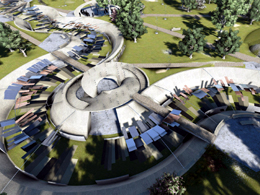STUDENTS PROJECTS
PROJECTS 2011
Students : Psarras Stamatios
Supervisor Professor: A. Liapi
University of Patra- Department of Architects Engineering
Presentation date: 04/11/11
From the linearity of time in the Musical Experience to the Spatial Experience of one continuous path: the disassembly of a Musical Piece and its conversion through filters of structure, note, counterpoint, perception and proportions into an Architectural path.

Architecture and music, although they use completely different media as arts, have many common elements. The composers of both arts often use common tools, such as repetition in counterpoint but also in architecture and they often depend upon mathematics and proportions. At the same time, the human brain perceives their works with similar rules and mechanisms, in accordance with the Laws of Gestalt Phycology that find application in both arts. My aim was to design a coherent transfer of the musical experience in space, converting the linearity of time during the hearing of a musical piece in one continuous path. To this end, the musical piece is used as a source of data, that through filters of analysis: Structure, Note, Counterpoint, Perception and Proportion are exported as spatial data.
These spatial data are part of a cultural Park, which includes a central path-open-air exhibition area, secondary routes, stops and semi-open areas, where music and sound events occur. In order to achieve the translation from a musical piece to a path, first the most objective and key elements had to be isolated. Some, such as timbre were omitted from the process, while the obstacle of lyrics was avoided by choosing a purely instrumental piece, specifically Air from the suite for strings in D major by Bach (BWV 1068).
Inside the path the musical notes are represented by spatial elements, grouped into three distinct parts, reflecting the distinctive roles of the instruments in Air. The bass is in constant motion in contrast to the other instruments and becomes the ground of the path (Walking bass line) while the other three instruments constantly alter roles, sometimes they are at the foreground and they become the roof of the path and sometimes they take an accompanying role in the background and they become its walls.
At the same time the internal structure of each organ is preserved. For example the plates on the ground follow the cello's theme: a series of four notes with a distinct pattern of going up seven notes, down one, down 6 (i.e. Octave Leaps). The form of the theme in the stave is transferred to the plates of the path, because the length of each plate is defined by the note's frequency and its position on the theme.
In addition, the plates follow a spiral path, imposed by the vertical plates of the background which serve as information panels and the space between them is intended for exhibitions. Thus, the visitor's route in the path is defined by the ground's plates which are aligned either to the left or to the right in correspondence to the background panels.
The Harmonographs are semi-open spaces, housing musical and sound events. Their shape follows the logic of the Harmonograph, an instrument that based on the proportions of the Pythagoras' scale converts notes into image. For the purposes of creating a three-dimensional shape, harmonograph has evolved from the classical two-dimensional instrument into three-dimensional. The proportions inserted in the 3D Haronograph are extracted from the proportions of notes of the basic path that are nearest to them.
Their functions complete the Park as an exhibition space: the Central Harmonograph has a small scene in the center, which has 360 vision thus giving the spectators the ability of a free and voluntary choice of the artistic experience. This is extended by elliptical ramps around the scene at various levels, giving the possibility of diversification of latitude. In addition, other Harmonographs attempt the merging of sound and music with other elements of space, light in the second and water in the last Harmonograph, into a unified experience.
Park D# has not simply been inspired by music but it is a consistent transfer of a music piece in space. The main path is a coherent spatial experience in many differences scales. Initially, the Structure of the composition, with the transfer of individual parts and musical phrases in the formulation of the shape of the path, then in the perception level by separating notes in accordance to the Law of Similarity, in different categories - components of the path, at the level of the Note with differentiation for frequency and duration, but also at the level of connections between the Notes-Counterpoint and finally, at the level of time with similar exposure speed of information. The imprint of the musical piece in the path is then diffused through guides throughout the Park and determines the location of all other elements: the secondary routes, stops, lighting and trees. These guides provide to the Harmonographs the most primitive elements of the musical piece, the mathematical proportions of its chords which are then imprinted into space. Finally, there is an attempt to merge sound and music with many elements, with regard to the visitor's interaction with the sound and the mental mapping of sound to these elements.
Using the same structure, the same concept, the same techniques and decisions we could say that the Park D# is in fact the musical piece Air.




















